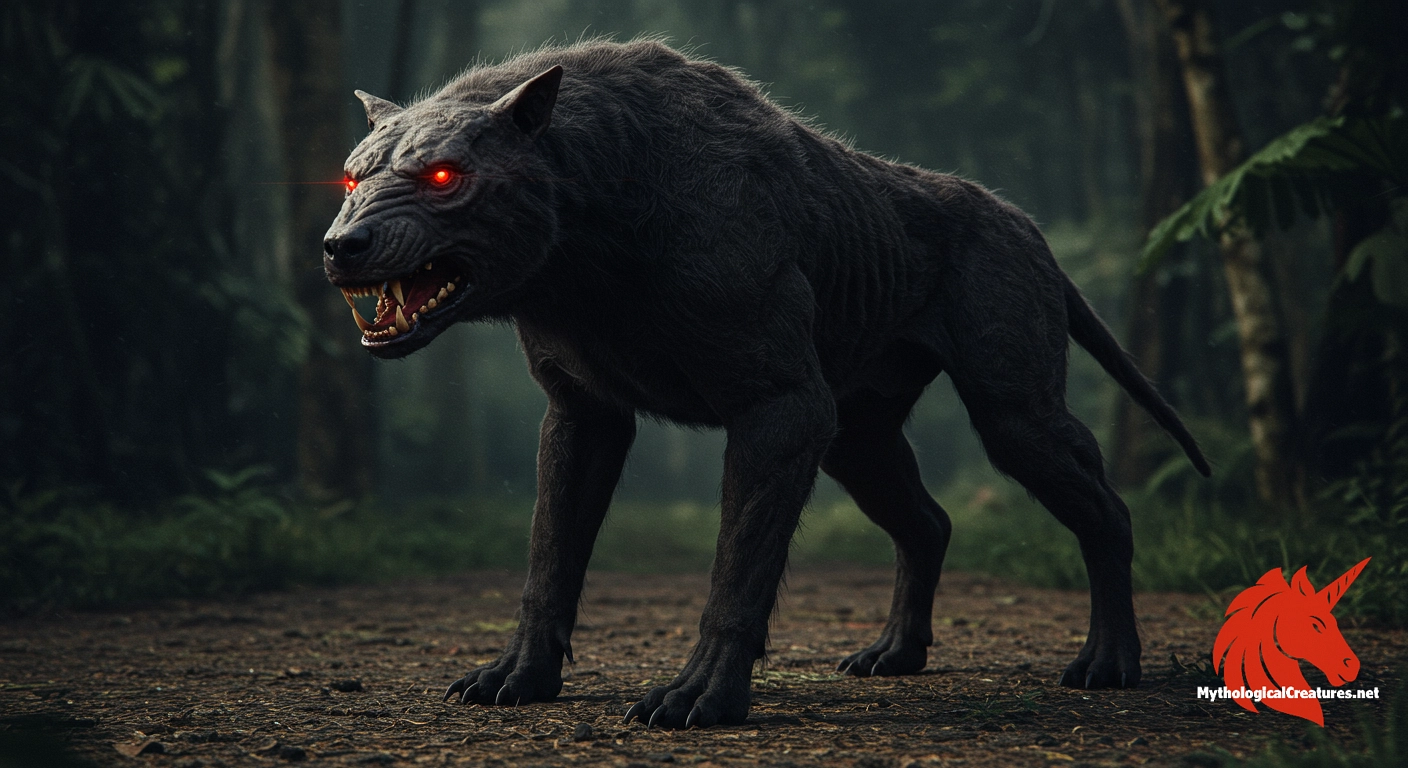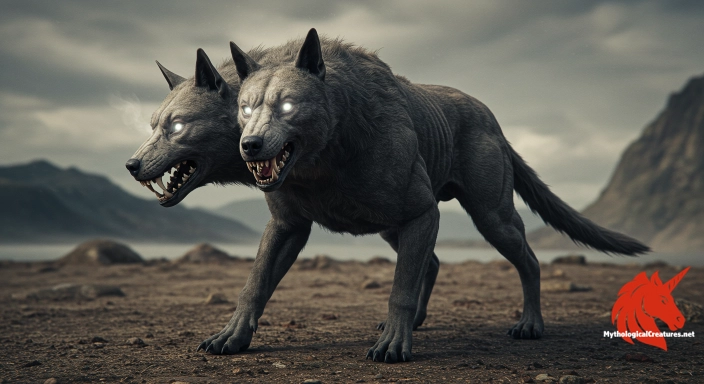Cadejo: The Cadejo is a supernatural, dog-like spirit from Central American folklore that appears in dual forms: a benevolent white version and a malevolent black version.

Cadejo
Cadejo - Represents the complex duality of protection and peril in Central American myth, influencing how travelers interpret signs of safety and danger during nocturnal journeys
Origins & First Encounters
The cadejo is a mysterious canine spirit that has long prowled the nighttime roads of Central America, emerging from a rich blend of indigenous and colonial myth. It is rooted in folk traditions that have been passed down through generations, evoking both awe and caution in its listeners. Early oral accounts and indigenous narratives describe the creature in ways that highlight its ambiguous nature, intertwining protection with peril. Often, the legend divides the creature into two distinct forms: a benevolent white iteration that safeguards wayfarers and a malevolent black form that seeks to end lives. The duality of its nature serves as a moral allegory about the balance of good and evil. Over time, its depiction has grown to symbolise not only physical danger but also the broader existential risks of straying from communal wisdom. The cadejo’s appearances along solitary roads at night underscore a timeless warning about the unseen forces lurking in darkness. Its enduring presence in the cultural memory of countries such as Guatemala, El Salvador, Honduras, Costa Rica, and Nicaragua reflects a deep-seated human need to explain the inexplicable. In this way, the legend of the cadejo transcends mere supernatural storytelling to become an emblem of the moral challenges inherent in the human experience. The myth continues to captivate audiences with its blend of mystery, caution, and the persistent allure of the unknown.
Source Texts & Tale Variants
Multiple sources have contributed to the multifaceted narrative of the cadejo. Oral traditions across Central America form the backbone of its lore, with communities recounting eerie tales during nightly gatherings. Regional storytelling in Guatemala, El Salvador, Honduras, Costa Rica, and Nicaragua has preserved a wide array of accounts that shape the creature’s dual nature. Literary works and regional anthologies have further solidified its presence, offering diverse descriptions and interpretations. One notable literary contribution is found in the work 'Los perros mágicos de los volcanes,' which vividly portrays the cadejo in a mythic landscape. Various folklore compilations provide alternative versions of the tale, sometimes highlighting the idea of a chain-dragging entity whose very name hints at its binding nature. In numerous accounts, the creature is portrayed not only as an omen of danger but also as a guardian for those otherwise vulnerable. Some textual records even conflate the cadejo with other local legends, thereby broadening its mythic repertoire. The heterogeneity of these sources showcases how the cadejo’s character has been reshaped by different communities over time. Such a collection of narratives—both written and spoken—illustrates the dynamic evolution of the legend. Ultimately, these intertwined sources confirm that the cadejo remains an influential figure in the cultural and mythological landscape of the region.
Form & Powers
Physically, the cadejo is depicted as a colossal, shaggy dog-like creature that merges familiar animal traits with supernatural embellishments. It is often described as being as large as a cow, its intimidating size enhancing its otherworldly presence. The creature’s eyes are a particularly distinctive feature, shifting from a calm blue to a vivid, burning red – or even purple – when it assumes an aggressive stance. Notably, its legs are said to resemble those of a deer or goat, complete with unusual hooved feet that defy ordinary canine anatomy. Its fur is frequently portrayed as wild and unkempt, adding to the mystique and unpredictability of its appearance. Many narratives also associate it with an overpowering, goat-like odour that announces its arrival. A recurring detail in some renditions is the image of the cadejo dragging a heavy chain, a characteristic that hints at its symbolic origins in the Spanish word for chain. The interplay of these physical features creates a vivid portrait that has captivated imaginations for generations. Its imposing form and shifting, luminescent eyes serve to reinforce the creature’s dual role as both protector and threat. Altogether, these striking visual details help sustain the cadejo’s enduring reputation as a creature that straddles the boundaries between natural and supernatural realms.
Regional Faces
The legend of the cadejo exhibits striking regional diversity across Central America. In Guatemala and El Salvador, local lore often casts a dual role on the creature, with both benevolent and malevolent versions coexisting. Some communities celebrate the white cadejo as a guardian that looks after vulnerable souls, particularly those who wander in isolation or under the influence of intoxication. In contrast, the black cadejo is frequently presented as a harbinger of doom, enticing travellers towards dangerous fates. Variations in the creature’s details are common, with some regions describing it as moving with a deer-like grace despite its canine form. The depiction of its eyes also varies, shifting between red and purple hues to signify its changing nature in different circumstances. In certain areas, the cadejo is even associated with peculiar local flora, such as bell-like flowers found only on volcanoes, which it is said to consume. These regional adaptations reflect local cultural values, fears, and the environment, ensuring that every retelling carries its own unique flavour. Through these multiplicative variations, the legend becomes a vibrant tapestry of shared yet distinct mythic narratives. This regional interplay not only preserves the story but also allows it to evolve and resonate with different communities over time.
Cultural Parallels
The cadejo shares thematic resonances with a variety of spectral canine figures found in mythologies around the world. It bears similarities to well-known British legends such as the Black Shuck and the Barghest, where ghostly dogs foretell misfortune. These parallel traditions emphasise the idea of an otherworldly hound that blurs the line between the natural and the supernatural. However, the cadejo is unique in its dual nature, balancing malevolence with acts of protection—a contrast not always present in its European counterparts. In many cultures, dogs are regarded as loyal guardians, yet the cadejo subverts this notion by also embodying sinister attributes. Similar motifs appear in Mesoamerican traditions, where animal spirits serve as both protectors and tricksters, thereby enriching the mythos with a nuanced symbolism. This cross-cultural comparison highlights the universal human tendency to ascribe mystical roles to familiar creatures. The ability of the cadejo to operate as both a benefactor and a threat resonates with broader mythological themes surrounding the duality of existence. Such connections underline an enduring cross-cultural fascination with the spectral canine, showcasing how similar archetypes can adapt to fit distinct societal contexts. In blending these elements, the cadejo stands out as a compelling instance of how shared mythic symbols can be uniquely transformed by their cultural environments.
Legacy & Modern Evolution
The evolution of the cadejo from an ancient superstition to a modern myth underscores its persistent allure in popular imagination. Over the centuries, its portrayal has been reshaped by shifting cultural landscapes, merging indigenous spiritual beliefs with later European influences. Early narratives conveyed a simple warning against the perils of night travel, while later retellings have added layers of moral complexity and dual symbolism. Contemporary depictions often present the cadejo as a multifaceted figure, at once a protector of the desperate and a sinister force urging individuals towards self-destruction. This evolution is evident in literature, visual arts, and local festivals where the creature is invoked to represent various societal dilemmas. Modern reinterpretations have also transformed the cadejo into a symbol of the ambiguity inherent in the human condition, bridging ancient lore with current themes of vulnerability and resilience. Its recurring presence in media and artistic expressions highlights its enduring capacity to capture the imagination of a diverse audience. As communities continue to reinvent the legend, the cadejo remains a powerful icon that reflects both historical traditions and contemporary anxieties. This dynamic evolution ensures that the myth retains its relevance and continues to provoke thoughtful reflection. In sum, the legacy of the cadejo exemplifies the timeless power of myth to adapt and inspire across generations.
Interesting Fact
An intriguing aspect of the Cadejo legend is its dual manifestation, whereby the same spirit can be both a benevolent guardian and a malevolent predator, challenging simplistic notions of good and evil in folklore.
Quick Creature Info
Origin:
Associations:
Our Mythic Legendary Rating:

Also Sometimes Known As:
Habitat:
Supernatural Powers:
Physical Attributes:
Abilities:
Behavior:
Lore:
Related Creatures, Tales or Lore
References
Discover Another Mythical Legend You May Not Have Heard Of?
Uncover the mysteries of ancient folklore and expand your knowledge of legendary beings from cultures around the world.
Dare to Meet the Orthrus....
Mythical Disclaimer: The images and data on this site are derived from various historical and literary sources, but we have found that many myths often have multiple versions and interpretations across references, sometimes contradictory. As a result, these creature depictions are artistic interpretations—imaginative blends of folklore, legend, and a dash of AI guesswork. Because creature descriptions vary widely, our illustrations and accompanying information represent our best effort to honor mythology while bridging creative gaps. Enjoy these interpretations—just remember, we've done our best to respect the stories and validate available data, but in the realm of mythology, details often shift, imagination leads the way, and nothing is ever set in stone!
Curated by the Mythological Creatures Team (rev. May 2025)
